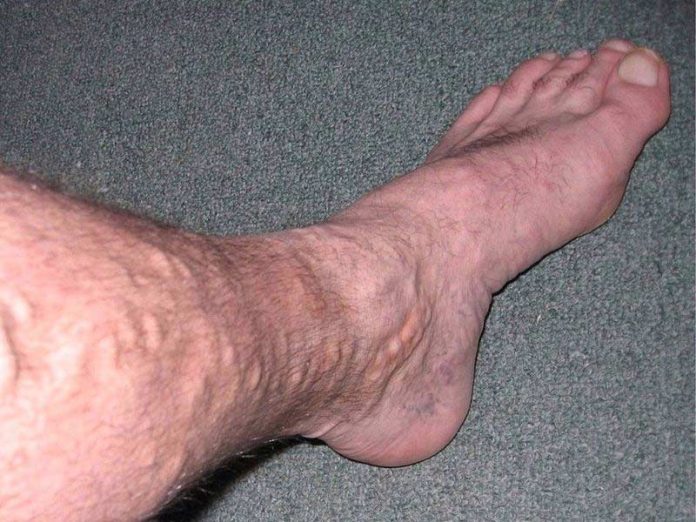
What are Varicose Veins?
Varicose veins aren’t most women’s favorite things to see when they pop up but around twenty-three percent of Americans have them. Varicose veins are unfortunately very likely to be genetic and women possibly have more than double the chance as men to get them. Most varicose veins can be quite harmless, despite the unsightliness of them.
Varicose veins are the engorged thick blue veins that you may see right under the layers of your skin. They are prominently visible likely due to them being kinked up instead of straight like normal veins usually are. Sometimes this can cause small areas of flooded capillaries that you may know as spider veins and can also be known as a superficial type of varicose veins. If varicose veins get inflamed they can affect your circulation and possibly cause itchiness of your skin, your ankles to swell up, or even aching in your limbs.
Symptoms of Varicose Veins
- Uneasiness in the legs
- Skin rashes
- Swelling
- Cramps, throbbing ache
- Restlessness in the legs
- Ulcers
- Itching around the veins
How Varicose Veins are Different
Throughout almost every vein there are valves that have a kind of cup-like shape to them. These funny looking valves tend to be rather important to try and let the proper amount of blood pass through your veins and then try to stop at just the right time to hopefully prevent too much blood to come through the vein at one time. Your veins most likely need to rely on the muscle tissue around them to push blood to other parts of your body like your heart, lungs, and brain.
Varicose veins may not function like normal veins because of their possible twisted form. The valves in a varicose vein may not do what they should and might possibly cause pooling of blood into your legs, ankles, and feet. Since some veins are so close to your skin they may not have the support that other veins can get from your muscles and this can cause them to become varicose veins.
Risk Factors
Common things that would likely result in the formation of varicose veins can be anything that tries to put a significant amount of pressure on your lower body, legs, and even your stomach. Other possible things that can cause varicose veins are things like obesity, tumors, a prior leg injury, frequent constipation, standing up for long periods of time, and being stationary for significant amounts of time. Your family history and your age can also play a part in the formation of varicose veins. Other factors which can be responsible for varicose veins:
- blood clot history
- oral contraceptive pills
- hormone replacement therapy or hormonal changes in menopause or puberty
- pregnancy
- too tight clothing or girdles
- obesity
- prolonged sun exposure
Pregnancy and Varicose Veins
During pregnancy, you may notice new varicose veins being created or even possibly having aggravated pre-existing varicose veins. Even haemorrhoids can be considered a type of varicose veins and possibly form during pregnancy. The presence of varicose veins during pregnancy can cause those miserable symptoms of painful or swollen feet or ankles. The longer you are on your feet the higher the possibility of having those symptoms if you are pregnant.
When your uterus expands, it can put more pressure on the largest vein that goes down into your legs and likely affects the flow and pressure of your blood to your legs. When you are pregnant the level of progesterone in your body can significantly increase and possibly help relax the inner layer of your veins but since your body is likely producing almost double the amount of blood it was before it can also be adding a taxing strain to your veins. Try sleeping on your left side to help alleviate pressure from your uterus on your vein. Varicose veins can significantly improve after you deliver your baby and may likely go away if you never had any varicose veins before pregnancy.
Treatment
If you are going to be sitting or standing for extended periods of time, try wearing compression leg sleeves which are designed to provide relief for varicose veins and their symptoms. Compression leg sleeves are made to try and push the blood in your legs upwards and can possibly offer you the most relief. You can try resting periodically throughout the day and raise your legs for around ten to fifteen minutes each break.
Exercise can also improve varicose veins by potentially improving circulation. Non-prescription medications for inflammation like ibuprofen can help with pain and swelling that you may be experiencing. If you think you might have varicose veins deep inside your legs you may want to consult a doctor for proper medical treatment.
Prevention
Preventing varicose veins can be as simple as exercising to promote better blood flow and possibly help strengthen your muscles in your legs. If you are obese, you may want to consider trying a new diet to lose weight and help take pressure off of your lower body. Quitting smoking can significantly reduce your likelihood of forming varicose veins. Try not to wear tight-fitting clothes because they can constrict blood flow.
Try not to wear high heels for long periods of time or stand for long periods of time. They both can significantly reduce your body’s ability to circulate your blood properly. If you are pregnant, try to stay within your recommended weight your doctor gave you and try to prop your legs and feet up around the same level as your heart as much as possible.








